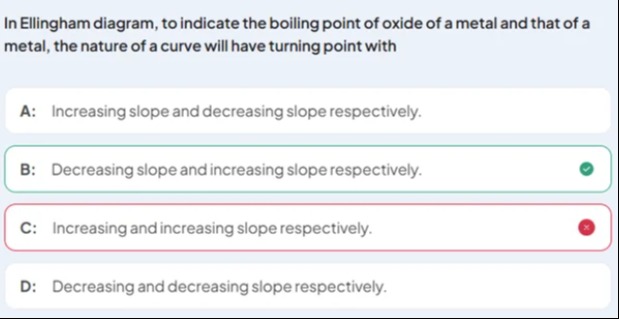Question
Question: In Ellingham diagram, to indicate the boiling point of oxide of a metal and that of a metal, the nat...
In Ellingham diagram, to indicate the boiling point of oxide of a metal and that of a metal, the nature of a curve will have turning point with

Increasing slope and decreasing slope respectively.
Decreasing slope and increasing slope respectively.
Increasing and increasing slope respectively.
Decreasing and decreasing slope respectively.
Decreasing slope and increasing slope respectively.
Solution
Ellingham diagrams plot the standard Gibbs free energy change (ΔG∘) for the formation of metal oxides as a function of temperature (T). The general reaction is xM(s)+y/2O2(g)→MxOy(s). The relationship between ΔG∘ and T is given by the Gibbs-Helmholtz equation: ΔG∘=ΔH∘−TΔS∘.
In an Ellingham diagram, the plot of ΔG∘ versus T is approximately a straight line with slope equal to −ΔS∘. The standard entropy change (ΔS∘) for the formation of a solid metal oxide from a solid metal and gaseous oxygen is generally negative because the number of moles of gas decreases (oxygen is consumed). Thus, the slope −ΔS∘ is generally positive.
Phase transitions of the reactants or products cause abrupt changes in the value of ΔS∘, and hence in the slope of the ΔG∘ vs T curve.
-
Boiling point of the metal oxide (MxOy): At the boiling point of the oxide, the oxide changes state from solid to gas (or liquid to gas). Let's consider the transition from solid to gas for simplicity, as the entropy change is most significant here. The reaction changes from xM(s)+y/2O2(g)→MxOy(s) to xM(s)+y/2O2(g)→MxOy(g). The original entropy change is ΔSsolid_oxide∘=S∘(MxOy(s))−xS∘(M(s))−y/2S∘(O2(g)). The new entropy change is ΔSgaseous_oxide∘=S∘(MxOy(g))−xS∘(M(s))−y/2S∘(O2(g)). Since S∘(MxOy(g))>S∘(MxOy(s)), we have ΔSgaseous_oxide∘>ΔSsolid_oxide∘. The slope of the curve is −ΔS∘. The new slope is −ΔSgaseous_oxide∘ and the old slope is −ΔSsolid_oxide∘. Since ΔSgaseous_oxide∘>ΔSsolid_oxide∘, it follows that −ΔSgaseous_oxide∘<−ΔSsolid_oxide∘. Thus, at the boiling point of the oxide, the slope of the curve decreases.
-
Boiling point of the metal (M): At the boiling point of the metal, the metal changes state from solid to gas (or liquid to gas). Let's consider the transition from solid to gas. The reaction changes from xM(s)+y/2O2(g)→MxOy(s) to xM(g)+y/2O2(g)→MxOy(s). The original entropy change is ΔSsolid_metal∘=S∘(MxOy(s))−xS∘(M(s))−y/2S∘(O2(g)). The new entropy change is ΔSgaseous_metal∘=S∘(MxOy(s))−xS∘(M(g))−y/2S∘(O2(g)). Since S∘(M(g))>S∘(M(s)), we have −xS∘(M(g))<−xS∘(M(s)). Therefore, ΔSgaseous_metal∘<ΔSsolid_metal∘. The slope of the curve is −ΔS∘. The new slope is −ΔSgaseous_metal∘ and the old slope is −ΔSsolid_metal∘. Since ΔSgaseous_metal∘<ΔSsolid_metal∘, it follows that −ΔSgaseous_metal∘>−ΔSsolid_metal∘. Thus, at the boiling point of the metal, the slope of the curve increases.
The question asks about the nature of the curve at the turning point corresponding to the boiling point of the oxide and that of the metal, respectively. Based on our analysis, the slope of the curve decreases at the boiling point of the oxide and increases at the boiling point of the metal.
